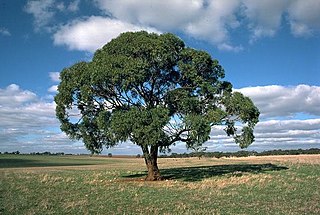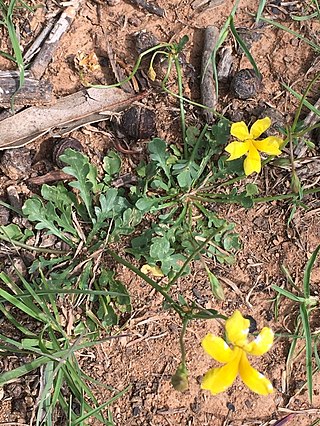
Banksia ornata, commonly known as desert banksia, is a species of shrub that is endemic to south-eastern continental Australia. The Ngarrindjeri people of the Lower Murray region in South Australia know it as yelakut. It has thin bark, serrated, narrow egg-shaped leaves with the lower end towards the base, cream-coloured flowers in a cylindrical spike, and later, up to fifty follicles in each spike, surrounded by the remains of the flowers.

Acacia retinodes is an evergreen shrub that is native to South Australia, Victoria and Tasmania. Short racemes of yellow flowers are produced periodically throughout the year. Some common names are Retinodes water wattle, swamp wattle, wirilda, ever-blooming wattle and silver wattle.

Diuris behrii, commonly known as golden cowslips, is a species of orchid which is endemic to eastern Australia. It occurs in South Australia, Victoria, New South Wales and the Australian Capital Territory. It has between three and six grass-like leaves and a flowering stem with up to four drooping, yellow flowers with dark streaks on the labellum. The flowers appear between September and November in its native range.

Eucalyptus odorata, commonly known as peppermint box, is a species of mallee or a small tree that is endemic to South Australia. It has rough, hard bark on the trunk and larger branches, smooth greyish bark on the thinner branches, lance-shaped adult leaves, flower buds in groups of between seven and eleven, white flowers and cylindrical or barrel-shaped fruit.

Prostanthera striatiflora, commonly known as jockey's cap, striated mintbush or striped mintbush, is a species of flowering plant that is endemic to the more arid areas of Australia. It is an erect, aromatic shrub with narrow egg-shaped to narrow elliptic leaves and white flowers with purple lines inside the petal tube.

Goodenia albiflora, commonly known as white goodenia, is a species of flowering plant in the family Goodeniaceae and endemic to South Australia. It is a small, erect shrub with ridged stems, elliptic to egg-shaped, cauline leaves, racemes of white flowers with leaf-like bracteoles at the base, and oval fruit.

Pimelea hewardiana, commonly known as forked rice-flower, is a species of flowering plant in the family Thymelaeaceae and is endemic to south-eastern continental Australia. It is a shrub with narrowly elliptic leaves and head-like clusters of 7 to 34 unisexual yellow flowers.
Caladenia behrii, commonly known as pink-lipped spider orchid is a plant in the orchid family Orchidaceae and is endemic to South Australia. It has a single narrow, hairy leaf and one or two creamy-white flowers with pink tips in early spring.

Caladenia tentaculata, commonly known as the eastern mantis orchid, large green-comb, green comb or fringed spider orchid is a plant in the orchid family Orchidaceae and is endemic to south-eastern Australia. It is a ground orchid with a single, hairy leaf and up to three green flowers with red stripes on the sepals and petals.

Leptospermum glaucescens, commonly known as the blue-green tea tree or smoky tea tree, is a species of shrub or small tree that is endemic to Tasmania. It has elliptical to egg-shaped leaves that are often greyish green, white flowers about 15 mm (0.59 in) in diameter arranged in consecutive leaf axils and fruit that remain on the plant for some time after maturity.

Prostanthera behriana, commonly known as tall mintbush, is a species of flowering plant in the family Lamiaceae and is endemic to the south-east of South Australia. It is an erect to straggling shrub with egg-shaped leaves and white, pale blue, pale violet or purplish white flowers with red-brown spots or purple streaks inside.

Sarcozona praecox, commonly known as sarcozona, is species of flowering plant in the family Aizoaceae and is endemic to Australia. It is a small erect to low-lying, succulent shrub with leaves that are triangular in cross-section and arranged in opposite pairs, and daisy-like flowers with twenty to eighty pink, petal-like staminodes and 20 to 150 stamens.

Goodenia calcarata, commonly known as streaked goodenia, is a species of flowering plant in the family Goodeniaceae and is endemic to Australia. It is an erect, annual herb with toothed egg-shaped to oblong leaves, racemes of white, cream-coloured or pink to mauve flowers with brownish markings, and oval fruit.

Goodenia pinnatifida, commonly known as cut-leaf goodenia, scrambled eggs or mother ducks, is a species of flowering plant in the family Goodeniaceae and endemic to Australia. It is a low-lying to ascending perennial herb with toothed to pinnatisect leaves, racemes of yellow flowers and more or less spherical fruit.

Triplarina imbricata, commonly known as creek triplarina, is a species of flowering plant in the myrtle family, Myrtaceae and is endemic to northern New South Wales. It is a shrub with weeping branches, narrow egg-shaped leaves, and flowers in pairs with five sepals, five relatively small white petals and fourteen to seventeen stamens.

Dampiera rosmarinifolia, commonly known as rosemary dampiera, is a flowering plant in the family Goodeniaceae.It is a perennial subshrub with linear leaves, mauve or purple flowers borne in leaf axils.

Spyridium coactilifolium, commonly known as butterfly spyridium, is a species of flowering plant in the family Rhamnaceae. It has white-velvety flowers and oval shaped leaves that are thickly covered in soft hairs.
Pomaderris flabellaris, commonly known as fan pomaderris, is a species of flowering plant in the family Rhamnaceae and is endemic to South Australia. It is a low shrub with fan-shaped leaves, and small clusters of woolly-hairy flowers.

Pomaderris helianthemifolia is a species of flowering plant in the family Rhamnaceae and is endemic to south-eastern continental Australia. It is a bushy shrub with hairy young stems, narrowly elliptic to lance-shaped leaves with the narrower end towards the base, and small panicles of hairy yellowish flowers.

Olearia brachyphylla is a species of flowering plant in the family Asteraceae and is endemic to southern continental Australia. It is a densely-branched, aromatic shrub with woolly-hairy stems, oblong to egg-shaped leaves with the narrower end towards the base and small white and pale yellow, daisy-like inflorescences.


















